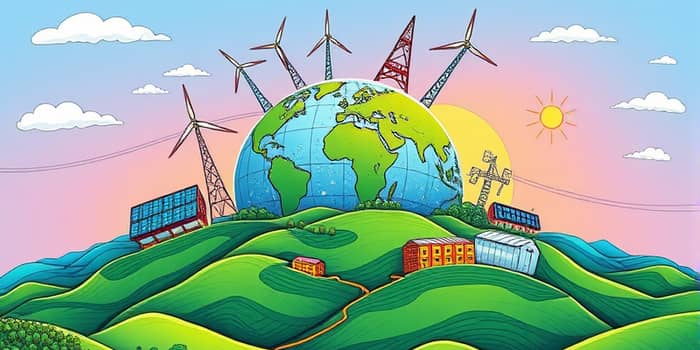
The landscape of global energy investment is undergoing a profound transformation. With mounting concerns over climate change, energy security and economic resilience, renewables have emerged as the centerpiece of a new era. Investors, governments and communities are uniting to channel unprecedented capital flows into clean technologies, reshaping power systems and industrial value chains across every continent.
From established markets to emerging economies, the scale and ambition of these investments reflect a collective determination to decarbonize energy production and unlock sustainable growth. The trends set today will carry profound consequences for generations to come.
In 2025, global energy investment is projected to reach an astonishing level, driven by an unwavering commitment to clean sources. This shift underscores a clear strategic pivot away from traditional fuels towards a diversified portfolio of renewable assets.
These figures mark a record high level of investment in the energy transition, signifying the growing confidence of financiers and policymakers in renewable technologies. Governments are rolling out supportive policies and incentives, while private capital seeks stable, long-term returns from clean power projects.
Several key factors are propelling this surge in renewables funding. Understanding these drivers helps reveal why investment is bound to continue its upward trajectory.
Across diverse markets, renewables not only offer cleaner energy but also greater price stability. Solar PV and onshore wind, for example, have become the lowest-cost sources of new electricity in dozens of countries, further entrenching their competitive edge.
Investment leadership can be seen in both scale and innovation. China has boldly positioned itself at the forefront, while Europe and select Latin American and African nations showcase impressive growth and pioneering projects.
These case studies illustrate how varied contexts can yield success when political will, stable financing and local expertise converge. In the United States, annual builds of wind and solar remain among the highest globally, even as these sources still account for under one-sixth of total electricity generation.
The renewable sector is characterized by both mature and emerging technologies. Solar PV, onshore wind and hydropower continue to absorb the lion’s share of capital, while newer solutions are unlocking further potential.
Economies of scale, global supply chain optimization and sustained R&D efforts have driven down component costs significantly. As a result, emerging applications like concentrated solar power and carbon capture are now on the cusp of commercial viability.
Despite this momentum, significant obstacles remain. A critical issue is the persistent imbalance in capital allocation across regions. Africa, despite holding 60 percent of the best solar resources, attracts only three percent of global energy investment.
Other hurdles include:
Addressing these challenges will require coordinated efforts from governments, development banks and the private sector. Strengthening legal frameworks, de-risking investments and expanding technical capacity are vital steps.
Renewable energy investments are not only reshaping power markets but also generating profound social dividends. The sector is inherently labor-intensive, creating jobs across construction, operation and maintenance.
Communities gain reliable electricity access, powering schools, clinics and businesses. Environmental benefits compound by cutting greenhouse gas emissions, helping nations meet their climate commitments.
Investment in the energy transition continues to break records. In 2024 alone, outlays reached $2.1 trillion, an 11 percent increase over the prior year. The scope of funding is also broadening beyond traditional renewables.
Future portfolios are likely to include:
Investment vehicles range from direct project finance to venture capital, infrastructure funds and green bonds. Public sector support, via grants and concessional loans, remains crucial in bridging early-stage financing gaps.
Robust policy frameworks underpin successful renewable deployment. National decarbonization targets, green recovery strategies and energy security initiatives have catalyzed investor interest worldwide.
Multilateral bodies and donor agencies are also stepping up. For example, the World Bank’s recent $1 billion commitment to hydropower in the Democratic Republic of Congo exemplifies how global cooperation can unlock projects in high-potential but underserved regions.
Strengthening international collaboration through knowledge sharing, standardizing regulations and aligning financial incentives will be critical to achieving equitable, sustainable energy access for all.
As we stand at the threshold of a new industrial revolution driven by renewable technologies, the decisions made by investors, policymakers and communities will define the trajectory of global development. By harnessing the combined power of finance, innovation and cooperation, we can create a resilient, low-carbon energy system that fosters prosperity for every nation and future generation.
References













